Related Research Articles

The Austrian Empire, officially known as the Empire of Austria, was a multinational European great power from 1804 to 1867, created by proclamation out of the realms of the Habsburgs. During its existence, it was the third most populous monarchy in Europe after the Russian Empire and the United Kingdom. Along with Prussia, it was one of the two major powers of the German Confederation. Geographically, it was the third-largest empire in Europe after the Russian Empire and the First French Empire.

Joseph Hormayr, Baron zu Hortenburg was an Austrian and German statesman and historian.
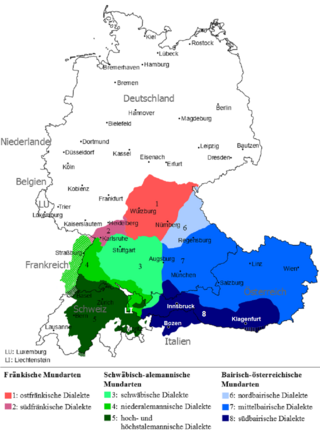
East Franconian or Mainfränkisch, usually referred to as Franconian in German, is a dialect which is spoken in Franconia, the northern part of the federal state of Bavaria and other areas in Germany around Nuremberg, Bamberg, Coburg, Würzburg, Hof, Bayreuth, Meiningen, Bad Mergentheim, and Crailsheim. The major subgroups are Unterostfränkisch, Oberostfränkisch and Südostfränkisch.

Wiener Spielkartenfabrik Ferd. Piatnik & Söhne, commonly referred to as Piatnik, is an Austrian playing card and board game manufacturing company based in Vienna.

Rams is a European trick-taking card game related to Nap and Loo, and may be played by any number of persons not exceeding nine, although five or seven make a good game. In Belgium and France, the game of Rams is also spelt Rammes or Rems, in Germany, Rams, Rammes, Ramsch, Ramschen, Ramscheln or Ramsen, in Austria, Ramsen and Ramschen, and, in America, Rounce. The basic idea is fairly constant, but scoring systems vary. It was a widespread European gambling and drinking game that is still popular today. During the 19th century, it was introduced as Rounce in America and played with a 52-card deck without any difference between simples and doubles and with no General Rounce announcement. In the modern German variety of the game, Ramscheln, the 7♦ is the second best trump ranking next below the ace.
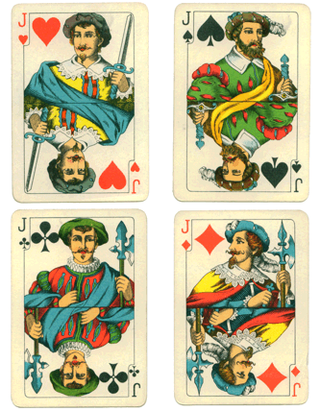
Grobhäusern is an historical German vying game in which players bet and then compare their 4-card combinations. It is played by two to eight players using a 32-card piquet pack. The game was illegal in most places. It was popular in rural Upper Saxony in the late 18th century.
Scherwenzel or Scharwenzel is an historical, south German, gambling game played with cards and named after the Unters or Jacks that had special privileges. It should not be confused with the north German card game of Scharwenzel, which is a relative of German Solo and in which the Jacks are permanent top trumps, below the black Queens and the trump 7.

Schweizerisches Idiotikon is an ongoing, major project of lexicography of the Swiss German dialects. Publication began in 1881 and is projected to be complete by 2022. Its scope includes the language since the end of the classical Middle High German period and as such also represents the historical dictionary of the dialects of German-speaking Switzerland, and is one of the most detailed treatments of the Early Modern High German language in general. As of 2010, it contains 150,000 words.

German Schafkopf is an old German card game and the forerunner of the popular modern games of Skat, Doppelkopf and Bavarian Schafkopf. It originated in Leipzig in the Electorate of Saxony. Today it is hardly ever played in its original form, but there are a number of important national and regional derivations.

The Deuce is the playing card with the highest value in German card games. It may have derived its name from dice games in which the face of the die with two pips is also called a Daus in German.

Brandeln is an historical card game for four players in which three play against a soloist. It is one of the earliest games to use the terms Bettel – a contract to lose every trick – and Mord - a contract to win every trick. One of several card games mastered by Mozart, Brandeln is still current in Austria and Germany today. It has been described as having a "civilized, refined and ingenious character" and "one of the most pleasant card games".
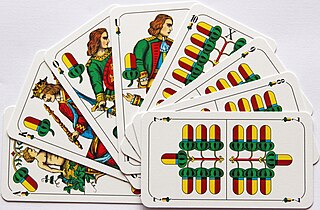
Wallachen is an Old Bavarian card game which used to be very popular in eastern Bavaria. Although, by 2012, it had become a rarer sight at pub tables, there have been more recent moves to revive it. Wallachen is a relatively simple three-hander that is easy to learn. As a result, like Grasobern, it has a relatively relaxed character without the mental demands of Schafkopf or the psychological stress of Watten. It is a member of the Préférence family of card games.
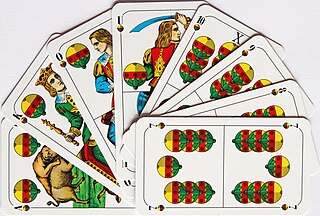
Bolachen is a traditional card game for 3 players that is played in parts of southern Upper Bavaria, especially in the Rupertiwinkel area of the Berchtesgaden Land, where there is a cultural influence from Salzburg, and the state of Salzburg itself. It is a Bavarian variant of the more complex, old Austrian game of Préférence. Like its Bavarian cousin, Wallachen, Bolachen is threatened by extinction.
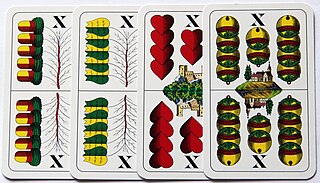
Matzlfangen is a traditional point-trick, card game for 4 players that originated in the Bavarian province of Upper Palatinate over 200 years ago and spread to Austria. It is still played in a few places today. The game is named after the Ten or Matzl, which plays a key role.
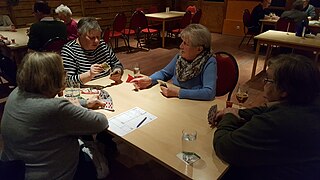
Fipsen or Fips is an old north German card game for 4 or 5 players that resembles British Nap in some respects. It is a trick-taking game played with a standard Skat pack that was once popular across North Germany in the former states of Schleswig, Holstein, Mecklenburg and Pomerania, but is now restricted to the south Holstein region. In the village of Thedinghausen in Lower Saxony, a rather different game is played under the same name for currant buns called Hedewigs. It has been described as "quite a special card game" that is "ancient, but very easy to learn".
Bester Bube or Fünfkart is an historical German card game for 3–6 players played with a Piquet pack. It is one of the Rams group of card games characterised by allowing players to drop out of the current game if they think they will be unable to win any tricks or a minimum number of tricks. It may be an ancestor of Five-Card Loo.
Jucker, also known as Juckerspiel or Juckern, is a card game that was popular in the Alsace and Palatinate regions on either side of the modern Franco-German border. It is believed to be the ancestor of Euchre and may have given its name to the playing card known as the Joker.
Franz Xaver Kleinheinz was an Austrian composer, piano teacher and Kapellmeister.
Franz Xaver Karl Gewey was an Austrian civil servant, and a writer and dramatist of popular satirical pieces.
Neunkart or Fett und Mager was a traditional North German card game played with 36 French-suited cards.
References
- ↑ Korabinsky (1784), p. 126.
- ↑ Verein für Geschichte der Deutschen in Böhmen (1895), p. 115.
- 1 2 Castelli (1847), p. 226.
- ↑ Lexer (1862), p. 148.
- ↑ Gewey (1814), p. 4.
- ↑ Bäuerle (1819), p. 55.
- ↑ Offenbach (1838), p. 29.
- ↑ Schatzmayr (1870), p. 47.
- 1 2 Moser (1860), pp. 47–48.
- ↑ Ebersberg (1870), p. 298.
